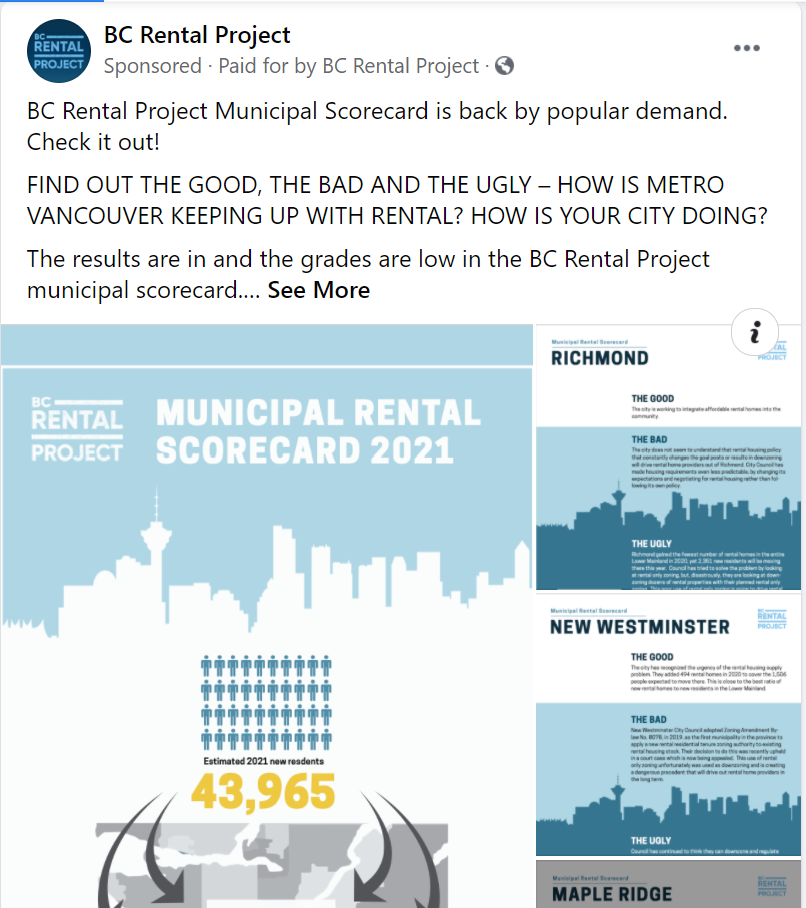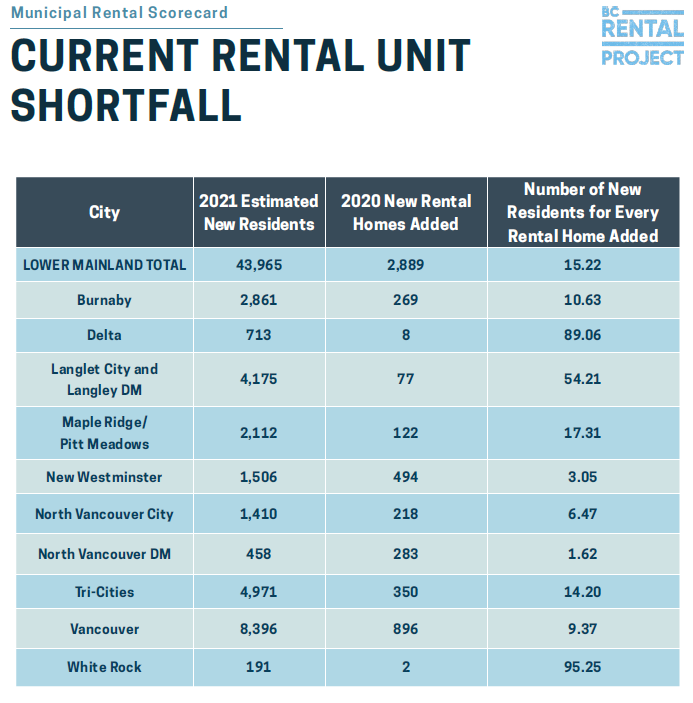I’m going to get a little polemic here. A friend sent me a note asking about this Facebook post, and why New Westminster has such a low grade in supporting renters:
The post is actually a paid advertisement from a shadowy group calling themselves The Rental Project, and I’ve seen their work before. It’s not surprising that my friend saw this ad. He is a renter who spends some time online talking about the housing crisis, and The Rental Project spent more than $56,000 on Facebook ads in the last couple of years selling bunk like this in the Greater Vancouver area. $56K on Facebook will definitely get you some notice.
Perhaps it’s not really fair to call this group shadowy, because they don’t even come out into the shadows. At the surface, it looks like a grassroots group of people supporting renters and the needs of renters in Metro Vancouver. Indeed, looking at comments on any of their Facebook posts ads and you see responses from people concerned about affordable housing and policies to protect renters. But look at The Rental Project’s webpage. There are no authors, no links to members, no indication who is collecting their data, writing their reports, or paying their staff to design $56,000 in Facebook Ads. It’s not even clear who you are financing if you choose to click the prominent DONATE button.
This is Astroturf. A campaign made to look like a Grassroots effort, but clearly green-coloured plastic standing in place of grassroots. The reality of who is behind it is the story behind New Westminster’s “D” score.
If you look at the “report” being promoted in this ad, the first thing you may notice is that it is lacking in any cited sources or links for their information (though I have no reason to believe the numbers they report are untrue), and that the data and commentary that supports the letter grade headlines is inconsistent and incomplete. There is no mention of an author, and no way to connect to them to ask questions. The word shoddy is easily and fairly applied.
They award New Westminster a grade of “D” – their lowest grade (though they failed to grade the Langleys, Delta or White Rock). I’ll come back to the rest of their comments in a bit, but I want to look closer at the only actual quantitative data they provide, a short table in the end of the report:

I need to emphasize again that there are no citations, no indication where the numbers here come from, but even if we take them at face value, it shows New Westminster (Grade D) is filling rental need at a rate compared to population growth (their measure, not mine) greater than almost any other community listed. We are more than twice as good at meeting the demand as North Vancouver City (Grade A-) and three times that of Burnaby (Grade B). The only graded Municipality with a better rate of new rental vs. growth is North Vancouver District (Grade C) who achieve that statistic by growing at less than a third of the rate of New West. Invite no-one in, and you don’t need to build new housing. I’m not sure how that serves renters during a housing crisis, though.
Keen observers may note the comparisons here are bereft of actual population numbers (it would make sense that municipalities with 700,000 people should be building more rental on raw numbers than municipalities with 70,000). There are also a few municipalities missing, so I expanded the table out a bit to give a little more context. What do we learn?

New Westminster is building more rental per capita than any municipality rated. Much more than most.
So why the D grade? Why are we graded lower than Richmond, whose numbers they don’t provide but they describe as “gain[ing] the fewest number of rental homes in the entire Lower Mainland in 2020,” and West Vancouver, “did not increase the number of rental homes in the city in 2020. A divided council prevents the municipality from making the gains it needs”? Why the specific hate for New West?
Because we have protected the most affordable housing in the City.
This goes back to who is behind the well-financed Astroturf campaign . It is not organizations working to protect renters by supporting rental development in the community or preserving the affordability of rental across the region. It is an organization protecting the financial interest of Landlords, especially those using lower-cost rental as an investment vehicle, and those investing in REITs.
A few years ago, New West passed aggressive anti-demoviction and anti-renoviction Bylaws. The Landlord Lobby came after us hard. They bought advertising saying we were killing rentals, they came to Council and warned us of dire consequences for future rental development, they took us to court. And they launched Astroturf campaigns.
Their main argument was that these Bylaws were illegal, and that these types of policies would prevent any new rental being built. They were wrong. Not only are we still, three years later, leading the region in getting new Purpose Built Rental in the ground, we have had several major development projects shift from for-market-strata to Purpose Built Rental since these Bylaws passed, increasing by hundreds the number of PBR units in the pipeline, and being built as we speak.
These bylaw changes are so powerful that the Landlord Lobby has challenged them in court (and lost). Meanwhile, other cities from Port Coquitlam to Victoria are following suit and writing their own bylaws to provide the same protection in their communities. New West showed such leadership here that the provincial government changed the Residential Tenancy Act to provide some (but not all) of the protections we introduced in our Bylaw. At the same time, our Bylaw changes have literally prevented hundreds of lower income households in New Westminster from being demovicted or renovicted.
No wonder the big money REITs are scared and investing tens of thousands of dollars on political action. Their business model is based on finding “undervalued” rental properties – ones renting for less than the maximum market will bear – so they can jack rents and make a quick profit off putting lowest income people in the City out on the street. When that’s your business, it isn’t hard to find $50K to spend on Facebook ads that blame the unaffordability of rentals on the government. And to be clear, if that’s not the business model, if investors just want to invest in rental property, maintain it in good repair, and assure people have access to rentals at a variety of affordability levels, then they have nothing to fear from New Westminster’s Bylaw changes.
I’m damn proud of the staff of New Westminster for putting these Bylaws together, our legal advisors for assuring they are robust and defendable, and our Council for being bold enough to take these measures to protect some of the most vulnerable residents in our City when literally threatened by lobbyists for landlords and property speculators.
We can do more. Like every City in the region, we can and should be doing more to support affordability through this ongoing housing crisis. Self-evaluation is an important part of this – given funding constraints and limited land and conflicting priorities, it is important to track how we are doing compared to our cohort municipalities. As long as we are still building Purpose Built Rental at a region-leading rate, as long as we are also assuring affordable and supportive housing projects are coming to the City and are supported by our policy choices, and as long as we are preventing unnecessary renovictions and demovictions that turn homelessness into an investment vehicle, I will proudly wear the “D” grade from this deceitful Astroturf campaign as a badge of pride.
Adrian Crook, spokesperson.
I remember a few years back when he was a local celebrity in the local Twitter circles…..
I work for a local developer and I’d love to find a low rise project – rental or strata – to build in New West. I find my biggest challenge is navigating the city’s OCP. It seems like such a hodge podge. Designations often change mid-block, and the densities and heights do not seem to be well defined. This leaves me confused, and land owners (from whom I’m trying to buy land) thinking every one of their sites has way more potential density than is really achievable.
I hold the City off North Van as the gold standard for clarity of planning within the Lower Mainland. Well laid out intentions of type of housing allowed, max heights, densities (including a simple, straight forward community benefits program). Were New West to adopt similar, easy to follow guidelines, it sure would be easier to provide more housing in New West.